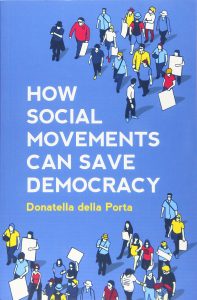In How Social Movements Can Save Democracy: Democratic Innovations from Below, Donatella della Porta explores how progressive social movements can deepen direct democracy through popular participation. The book repositions social movements as actors within institutional or formal politics and will inspire readers to consider their influence as citizens beyond traditional modes of participation in the public arena, writes Carla Quiroz.
How Social Movements Can Save Democracy: Democratic Innovations from Below. Donatella della Porta. Polity. 2020.
 Find this book (affiliate link):
Find this book (affiliate link):![]()
In How Social Movements Can Save Democracy, Donatella della Porta explores some innovative proposals from progressive social movements at a time when various crises challenge existing institutions, party systems have been shaken and democratic conceptions need to be legitimated. This valuable book proposes opportunities for institutions to deepen direct democracy through popular participation: for instance, through referendums ‘from below’ or constitutions.
The book is split into five parts. In the first chapters, the author argues that social and economic crises bring times of change, giving civil society the opportunity to discuss potential innovative contributions. While social movements have been studied as contentious actors, they have also nurtured new ideas. Social movements’ ideas can enter institutional politics to strengthen plurality and contribute to the deepening of democracy.
Della Porta emphasises the importance of democracy through the involvement of citizens. Her argument is focused on how we can restore democracy’s legitimacy and efficacy. Encouraging such participation is important both in and outside existing institutions, and through formal and informal checks, where collective activity can be articulated and demands can be resolved. Della Porta proposes different exchanges between various spheres of action where citizen participation is crucial — for example, through schools, neighbourhoods and factories — while still recognising the political role of social movements.

Image Credit: Photo by Santi Fox on Unsplash
During economic crises, waves of protest or moral disruption, social and grassroots movements push for political opportunities, increasing their capacity to pursue constitutional powers. In general, constitutions set up relations between the state and citizens and also protect the fundamental rights of the population and ‘common goods’. In this sense, classical sociologists such as Ferdinand Tönnies, Émile Durkheim and Max Weber have paid attention to the origins of constitutions; according to Chris Thornhill, constitutions regulate exchanges between different spheres of action, producing and reproducing power.
Nevertheless, della Porta refuses to think that constitutions are solely political. The author argues that constitutions also need to be supported by collective identification by political communities through popular participation, becoming a symbol of union. To describe how social movements facilitate the progressive aspects of constitutional processes, she provides two examples. The first of these is Iceland, which suffered a financial crash in 2008. This crisis allowed Iceland to reconstitute a social pact through a constitutional process that was highly pluralistic in terms of the background of citizens. The second is the Irish constitutional process, which was also pushed by the crisis. Activating participation through the appropriation of opportunities, resource mobilisation and collective framing emerges as a way to regain political legitimacy and empowerment.
Referendums from below have also been promoted by social movements. Referendums from below are described as direct democracy, involving social movements and civil society organisations in referendum campaigns. Della Porta includes some examples to explain this, including the case of the privatisation of the water supply in Italy, the referendum on Scottish independence and the pseudo-referendum on Catalonian independence. While it is true that referendums are usually a response to political discontent, they can contribute to the reinvention of democratic government through popular participation.
Following this idea, referendums imply an open channel of participation where participatory democracy is promoted by progressive social movements, in contrast to simple delegation by a political elite. Social movements can be successful in promoting referendums themselves, but they can also appropriate referendums that have been promoted by political elites, introducing their own strategies. From time to time, social movements can even be seen as offering a moderate path of contentious action. Della Porta claims that usually social movement scholars have focused on party elites, the media and the public; however, it is important to consider the contribution of citizens or the grassroots as producers of messages too.
In the fourth chapter, della Porta reclaims the historical indifference between two fields of study: the study of political parties and the study of social movements. While studies of political parties mainly focus on elections and activities within institutions, social movements are mainly located outside institutions. However, they are mutually dependent as institutional politics is usually permeated by social movements as actors in the political system. Through this line of thinking, della Porta defines the concept of ‘movement parties’, which emerge as a hybrid of the two. According to Herbert Kitschelt’s definition, ‘movement parties are coalitions of political activists who emanate from social movements and try to apply the organization and strategic practice of social movements in the arena of party competition’.
Movement parties have emerged where crises have been faster and where citizens have supported radical changes. This overlap between political parties and social movements aims to link memberships and organisational actions, integrating institutional politics and ideological militancy. The emergence of this kind of political party is facilitated when economic and political crises produce grievances and people cannot find existing channels of representation in the party system and traditional coalitions. In this context, new movement parties emerge usually on the Left, appropriating opportunities and symbolic resources to put forward claims for social justice, equality and democracy. The author develops these ideas by looking firstly at Podemos as a movement party in Europe, and secondly at Movement towards Socialism (MAS) in Latin America.
How Social Movements Can Save Democracy offers a deeply contextual and theoretical approach, giving examples drawn from across the world. The book’s biggest contribution is opening a reconfiguration of social movements as actors within institutional or formal politics. It also inspires the reader to think about the opportunities associated with political and economic crises as a space of ongoing learning. The book therefore works as a tool to position the reader as a citizen who can influence the use of referendums or other examples of popular participation, challenging the government and political elites as well as traditional modes of participation in the public arena.
How Social Movements Can Save Democracy suggests that crises offer the opportunity for social movements and civil society to co-produce, or at least influence, future institutional changes. Popular participation through direct democracy using more sophisticated techniques could ensure a better quality of democracy: more effective and plural where the grassroots are represented by citizen-led democratic innovations.
Note: This review gives the views of the author, and not the position of the LSE Review of Books blog, or of the London School of Economics and Political Science. The LSE RB blog may receive a small commission if you choose to make a purchase through the above Amazon affiliate link. This is entirely independent of the coverage of the book on LSE Review of Books.







